This article first appeared in The Jester issue 492
To celebrate the centenary of Bairnsfather’s original cartoon, this is the first of two articles by Club member Mark Warby looking at some of the many occasions when the “better ‘ole” has been used by other cartoonists, as well as some of Bairnsfather’s own later published versions of it.
 Bruce Bairnsfather sent his first cartoon to The Bystander in March 1915, while serving as Machine Gun Officer with the 1st Royal Warwickshire Regiment in Belgium. Blown up by a shell during the Second Battle of Ypres in April 1915, he was sent home to England, and while recovering began a regular series of drawings for The Bystander, which continued throughout the war. Compilation volumes of his Fragments from France sold over 1 million copies, and his cartoons were reproduced on all manner of merchandise, from postcards, playing cards and jigsaws to handkerchiefs, and even a range of Bairnsfather Ware china. His most popular character was Old Bill, a typical old soldier who the men fighting at the front and their families back home took to their hearts. Everyone knew an Old Bill type, and their husbands and sons would write home telling them how life at the front was just as Bairnsfather drew it. Old Bill went on to appear in books, plays and films, and in 1919 Bairnsfather was credited as “the man who made the Empire laugh in its darkest hours.”
Bruce Bairnsfather sent his first cartoon to The Bystander in March 1915, while serving as Machine Gun Officer with the 1st Royal Warwickshire Regiment in Belgium. Blown up by a shell during the Second Battle of Ypres in April 1915, he was sent home to England, and while recovering began a regular series of drawings for The Bystander, which continued throughout the war. Compilation volumes of his Fragments from France sold over 1 million copies, and his cartoons were reproduced on all manner of merchandise, from postcards, playing cards and jigsaws to handkerchiefs, and even a range of Bairnsfather Ware china. His most popular character was Old Bill, a typical old soldier who the men fighting at the front and their families back home took to their hearts. Everyone knew an Old Bill type, and their husbands and sons would write home telling them how life at the front was just as Bairnsfather drew it. Old Bill went on to appear in books, plays and films, and in 1919 Bairnsfather was credited as “the man who made the Empire laugh in its darkest hours.”
Exactly one hundred years ago, on 24 November 1915, The Bystander magazine published what would become Bairnsfather’s most famous cartoon – and one of the most well-known and enduring cartoons of all time – “Well, if you knows of a better ‘ole, go to it!”
Vivian Carter, Editor of The Bystander, later explained what made “Well if you knows of a better ‘ole go to it” so successful: “Christmas, 1915, marked the lowest level of the Allied fortunes, and angry pessimism was the note of the day. We, the Allied nations, were in an ‘ole, and we knew it, and the question we were all wrangling about, between bombardments, was whether the future was going to show things worse, or possibly better. There was therefore a symbolism about the ‘Better ‘Ole’ picture that raised it altogether above the ordinary ’Fragment’ level.”
The Editor went on to say: “The public saw it and collapsed. It was the limit. A funny picture enough, that of two men engaged in a furious squabble in the midst of a bombardment, but the question of the quarrel – ie, whether by any possible chance either of them could be in a worse predicament – seemed somehow to hit the public in its tenderest spot…no cartoon of the war, in actual fact, hit the public so much as that of the two desperate men in that Johnson ‘ole.”
In comparison to Vivian Carter, Bairnsfather himself “did not think so much of this drawing at the time” and felt it was “no better or worse than the other sketches I had been doing.”
In the one hundred years since Bairnsfather’s drawing was first published in The Bystander, his caption and/or “better ‘ole” theme has been borrowed and adapted by over 130 cartoonists in more than 200 cartoons published in newspapers and magazines in seven countries. At least ten British Prime Ministers, eight US Presidents, four Australian, two Canadian and one New Zealand Prime Ministers have been depicted in that famous setting, along with two Russian Presidents and one King – not forgetting those two progenitors of the First and Second World Wars, Kaiser Wilhelm and Adolf Hitler.
To celebrate the centenary of Bairnsfather’s original cartoon, this is the first of two articles looking at some of the many occasions when the “better ‘ole” has been used by other cartoonists, as well as some of Bairnsfather’s own later published versions of it.
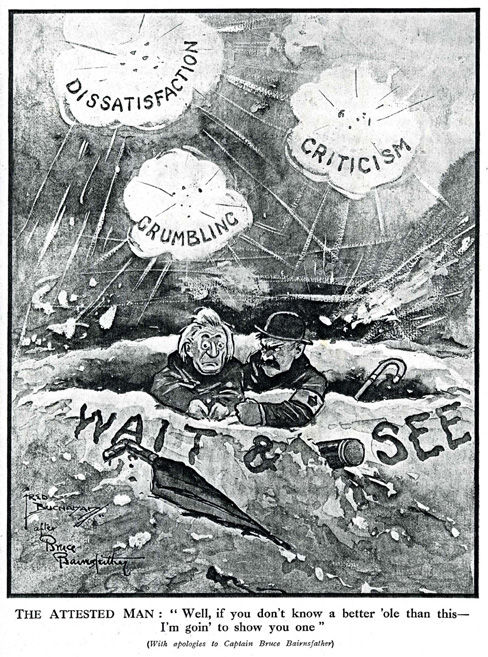 The first known occurrence of another cartoonist ‘borrowing’ the “better ‘ole” was on 19 April 1916 when The Bystander published a drawing by another regular contributor, Fred Buchanan, then serving with the Artists Rifles, showing an Attested Man in a shell-hole, telling his companion “Well, if you don’t know of a better ‘ole than this – I’m goin’ to show you one.”
The first known occurrence of another cartoonist ‘borrowing’ the “better ‘ole” was on 19 April 1916 when The Bystander published a drawing by another regular contributor, Fred Buchanan, then serving with the Artists Rifles, showing an Attested Man in a shell-hole, telling his companion “Well, if you don’t know of a better ‘ole than this – I’m goin’ to show you one.”
Four months later, on 28 August 1916, it was parodied by Australian cartoonist George Taylor, in the Construction and Local Government Journal, with NSW Premier William Holman and a disgruntled Labour Leagueite in the ‘ole.
For the Christmas 1916 number of Truth, Stranger Pritchard had Ireland as the ‘ole, with Sir Edward Carson and John Redmond debating the Home Rule question.
A football result led to another interpretation. After Stoke beat Liverpool, on 24 February 1917 the Birmingham Sports Argus cartoonist had a pottery jar (representing Stoke) telling a sailor (Liverpool) “If you know of a better ‘ole than Stoke, go to it.”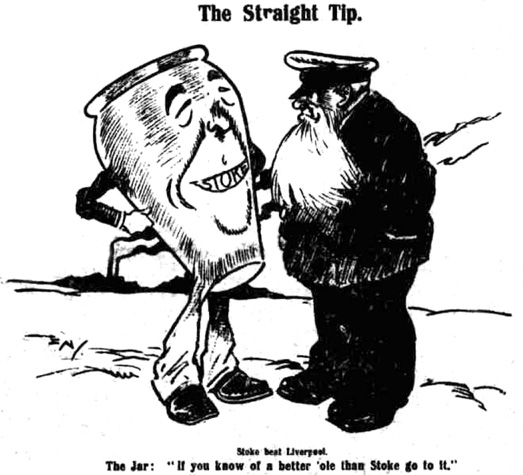
In 1917-18 Bairnsfather visited the American Army in France, prompting him to revisit the better ‘ole setting, this time with Old Bill and an American soldier ‘Both in the same ‘ole now’ published in The Bystander on 24 July 1918.
 By the end of the war Bairnsfather’s by now famous cartoon had been parodied at least five times. The last occasion was in Melbourne Punch on 18 October 1918, just weeks before the Armistice, when James C Nuttall put the Kaiser in the ‘ole, telling Prince Maximillian of Baden, recently appointed Chancellor of the German Empire, “I wish I knew a better ‘ole.”
By the end of the war Bairnsfather’s by now famous cartoon had been parodied at least five times. The last occasion was in Melbourne Punch on 18 October 1918, just weeks before the Armistice, when James C Nuttall put the Kaiser in the ‘ole, telling Prince Maximillian of Baden, recently appointed Chancellor of the German Empire, “I wish I knew a better ‘ole.”
The first known version of the better ‘ole by an American cartoonist came in February 1919 when ’Ding’ Darling drew President Wilson telling Congress “if you know a better ‘ole go to it” in a drawing titled ‘The League of Nations argument in a nutshell’ for the Des Moines Register.
On 17 May 1919 New Zealand Observer cartoonist Blo (William Blofield) put NZ Prime Minister William Massey and opposition leader Joseph Ward in the better ‘ole.
A month later Bairnsfather put Old Bill back in the ‘ole, in a special Victory Loan version captioned, ”if you knows of a better loan go to it.” Published in the Daily Express on 28 June 1919, the day the Peace Treaty of Versailles between Germany and the Allied Powers was signed, the original of this new drawing was offered to the highest bidder among readers of the Express.
When the General Strike was called in May 1926, Bairnsfather was living in New York, but responded with a cartoon (recently rediscovered) of Old Bill and Bert as mine workers, published in the Philadelphia Inquirer on 7 May 1926.
A few weeks later, American cartoonist Jesse Cargill had the British Government trying to decide, in the wake of the General Strike, which was the better ‘ole for them. Cargill used the better ‘ole theme in at least nine cartoons between 1924 and 1960.
On 8 July 1927 the St Louis Daily Live Stock Reporter became one of the most obscure newspapers to carry an adaption of the better ‘ole, when their cartoonist William Ferguson drew a farmer in the ‘ole, surrounded by an ‘agricultural battleground.’
On 17 October 1931 David Low (whose work Bairnsfather is known to have admired) used the theme in a cartoon for the Evening Standard. Neville Chamberlain, Max Aitken, Herbert Samuel and others were pictured sheltering in a battlefield crater, with Low giving the report “Battle now raging along entire front, important troop movements may be expected shortly. I distinctly heard Sergeant Beaverbrook tell Field Marshal Samuel that he was ordering all Tariff-Neutrals to be shifted to the Hot Place and if he (Samuel) knew of a better ‘ole, he could go to it.” Low again used the phrase in a cartoon published on 7 October 1933.
 From 1933-34 Bairnsfather contributed over 200 cartoons to the Daily Herald, which then had the largest circulation of any newspaper in the UK. Many of his later drawings for the paper had a sporting theme, and on 2 March 1934 the Herald published a cartoon of Old Bill and Bert atop a roof overlooking Wembley football ground, with a telescope to watch the Arsenal-Aston Villa cup tie, Old Bill telling Bert: ”If you knows of a better seat, go to it.”
From 1933-34 Bairnsfather contributed over 200 cartoons to the Daily Herald, which then had the largest circulation of any newspaper in the UK. Many of his later drawings for the paper had a sporting theme, and on 2 March 1934 the Herald published a cartoon of Old Bill and Bert atop a roof overlooking Wembley football ground, with a telescope to watch the Arsenal-Aston Villa cup tie, Old Bill telling Bert: ”If you knows of a better seat, go to it.”
From 1934 Bairnsfather actively supported the British Legion. He appeared at branches around the country, giving talks to help raise funds and boost membership. He also contributed a monthly cartoon series ‘The New Fragments’ to the British Legion Journal, and in October 1935 Number 17 in the series showed Old Bill and Bert in an updated version of the better ‘ole.
In August 1937 Toronto Daily Star cartoonist Les Callan drew Old Bill sat atop the Shanghai International Settlement as it was being bombarded during the Sino-Japanese War. The caption was “No better ‘ole, Bill?”
During a speech in Blackburn on 22 February 1939, Prime Minister Neville Chamberlain responded to critics of proposals to abandon steel shelters for deep shelters, by borrowing BB’s famous phrase, commenting “No doubt it would be comforting to think that in an air raid we could all get into a better ‘ole where we should be perfectly safe.” Two days later, Daily Express cartoonist Strube put the Prime Minister (‘Old Nev’) in the ‘ole with his ‘Little Man’, who he was telling “Better ‘ole? This is the better ‘ole.”
With war clouds looming ever closer, Strube’s cartoon was the last occasion the “better ‘ole” was used in a peace-time setting for six years.
In Part Two of this feature I’ll be looking at some of the many other “better ‘ole” cartoons from the Second World War through to the present day.





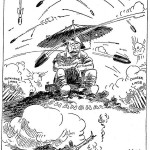
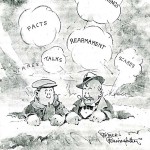
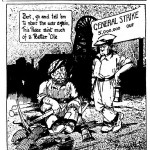
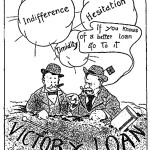

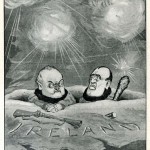
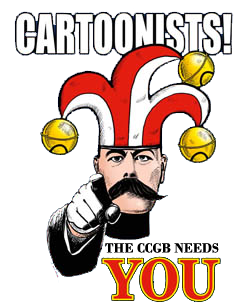
My father was an infantryman in the Royal Welsh Fusiliers on the Somme in 1916/17 and was inspired by Bairnsfather’s cartoons to start drawing himself, and I have many of his own cartoons about life in the trenches. His letters home were always upbeat and said almost nothing about the fighting,but the cartoons tell much more about his experiences. His two recurring themes were the constant threat of shelling and the water filled trenches and shell craters. If anyone is interested in seeing them,I will email them.